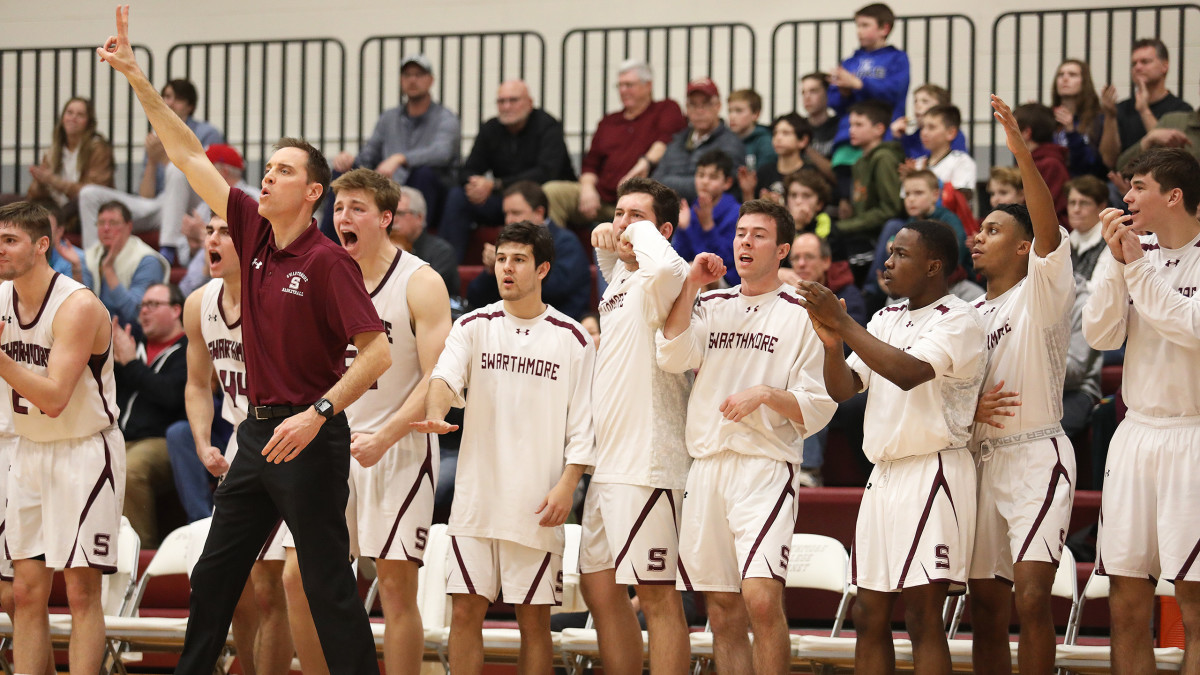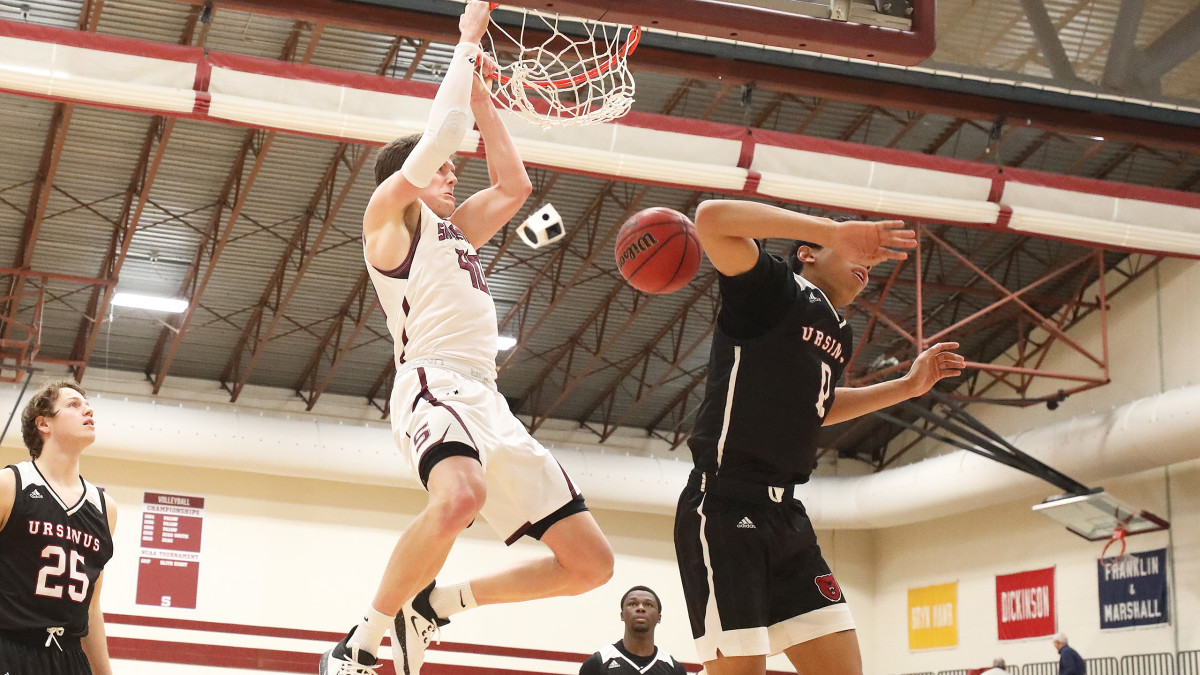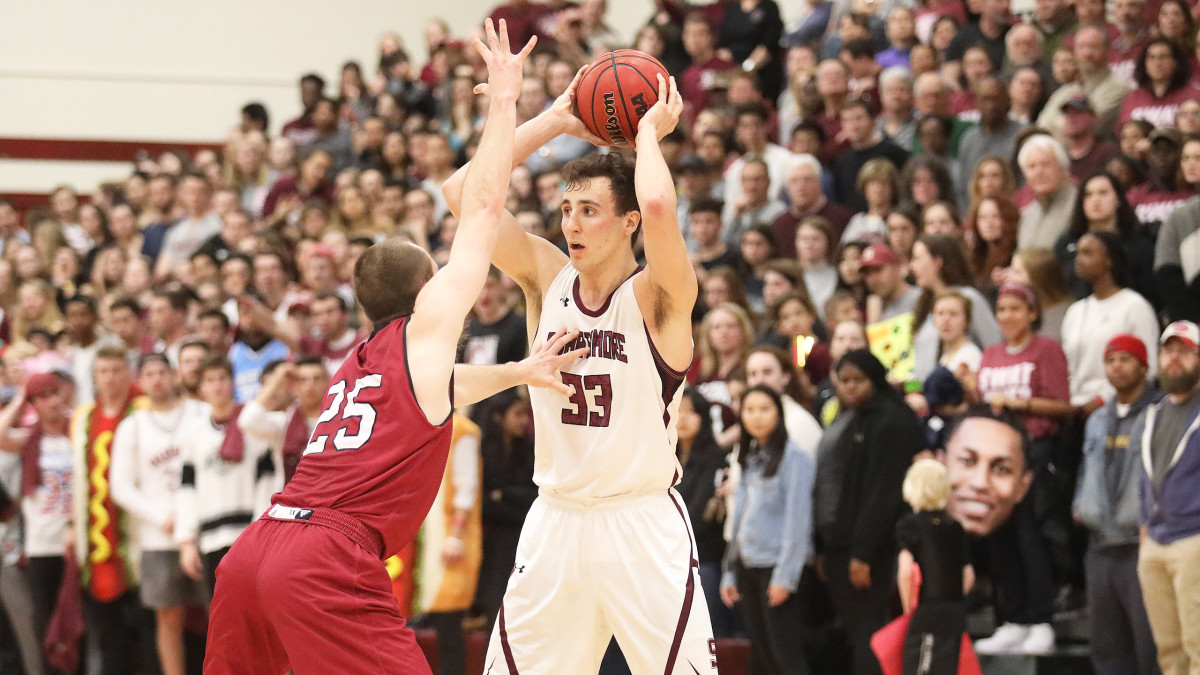How Academic Powerhouse Swarthmore Became the NCAA's Last Undefeated Men's Basketball Team

On Saturday night, Zac O’Dell and Nate Shafer were in their dorm alongside their teammates on Swarthmore College’s campus watching the 76ers-Bucks game when the senior co-captains' phones started blowing up. Shafer looked down to see an ESPN update stating that San Diego State had lost at home to UNLV, 66-63. The texts promptly rolled in. “Congrats, you guys are the last undefeated team,” many of them read.
Coming into last weekend, there were only two teams throughout the three divisions of NCAA men’s basketball that had yet to lose a game: Division I SDSU and Division III Swarthmore. The Garnet—by definition a red silicate mineral—are now the only team still undefeated, the lone men’s program to win all of its regular season games.
“It was kind of a weird environment,” O’Dell says, reflecting on receiving the news of SDSU’s loss. “Another team just lost, nothing really happened for us.”
“That was an interesting topic of conversation for about two minutes,” Shafer adds. “And then we moved on to something else.”
But conversations aside, the fact remains that one of America’s most rigorous and prestigious academic institutions also now sports the men’s basketball team that had the most successful regular season relative to its competition.

Swarthmore, located just 11 miles from Philadelphia, accepts just 9% of potential applicants, per the school’s 2018-19 Common Data set. It enrolled just 1,647 total students last year and its average SAT score was 1463. It’s shaped countless Nobel Prize winners, MacArthur geniuses and Rhodes Scholars. This year, it was also home to the preseason No. 1 in the D3Hoops.com poll.
Listen to members of the still No. 1 Garnet describe their success and it becomes clear that this season’s 25-0 campaign is a reflection of far more than just this year’s group. Instead, a culture has been engrained within them, emphasizing qualities that can be seen, heard and observed among other top programs across all levels of athletics.
Eight years ago, Landry Kosmalski showed up on Swarthmore’s campus—a place known more for its rolling lawns, vibrant arboretum and outdoor amphitheater than basketball. He had spent two stints as an assistant coach at Davidson, having once played there. He believed the two schools were similar and was aware of Swarthmore’s liberal arts environment. But Kosmalski admits, “I didn’t know a lot when I came for the interview.”
He felt comfortable, however, and was soon presented with the opportunity to run his own program. Before the former Davidson assistant had arrived on campus, Swarthmore had never made the Division III NCAA tournament. Now in Kosmalski’s eighth season, it’s made the tournament in each of the past four years—making O’Dell and Shafer part of the most successful class (basketball-wise, of course) in school history.
Kosmalski, 41, and his staff recruit a mix of players with stellar academic records who also have the ability to compete at an elite D-III level. He says some of his players can athletically compete at the Division II level and that others have the skill or talent close to D-I. “Whatever the reason, they just ended up with us,” he says. “Everyone has something unique to offer.”

Kosmalski notes that it’s clear his players understand the value of focusing on details. They are aware that countless small successes can pay off in a big way. O’Dell, a D3Hoops.com Preseason All-American First Team forward, adds that the team spends the majority of its time together, on and off the court. Moods are not determined by game results. And the co-captains deflect from taking credit for the program’s overall mindset, instead making sure to mention the countless players that preceded them.
“The culture is the foundation for any and all of our success,” Shafer, 21, says.
In each of the last five seasons the program has improved, both in terms of overall record and postseason success. Last year, it reached its first D-III title game in school history, falling 96-82 to UW-Oshkosh.
Playing in the Fort Wayne Mad Ants’ arena, a stadium with a maximum capacity more than 10 times that of Swarthmore’s Tarble Pavilion, the Garnet fell behind 11-0 to open the game. They missed each of their first six shots and couldn’t overcome the early deficit. Kosmalski notes that despite trailing throughout the contest, they continued competing, demonstrating the program’s character. Afterward in the locker room as members of the team reflected on the loss and overall season, they did so already looking toward the future. Players understood that next year represented a different challenge, one largely independent from the 2018-19 campaign. It was a sentiment that Kosmalski says he was surprised he didn’t have to voice himself.
Balance between academics and athletics is a core tenet of the team’s ethos. Large swatches of players visit libraries together after practice. Professors are supportive of the group and work with the team regarding class schedules. “You recognize the pinch points of the year,” Kosmalski adds. “Midterms, finals, making sure they get some extra time off and keeping practices as short as we can. One or two days of lack of sleep or a poorly planned practice can knock an athlete off. We’re just very cognizant of it.”
O’Dell and Shafer say they’ve tailored their schedules to have lighter course loads in their final semester, though they are far from devoid of academic pressures. O’Dell, a chemistry major, is a member of the American Chemical Society, and has presented some of his research at academic conferences. In the fall, he co-authored a paper entitled, “In Situ Quantification of Silver Nanoparticle Dissolution Kinetics in Simulated Sweat Using Linear Sweep Stripping Voltammetry,” becoming likely the only active college basketball player to see his work published in a recent issue of Environmental Science & Technology. He is currently applying to PhD programs, focusing on analytical or physical chemistry.

Shafer, an economics and psychology double-major, says he also has an outside chance of getting a paper he helped author published in an academic journal. He’s exploring the possibility of continuing his studies next year in the Victory Scholar Program, an organization designed in partnership with Northern Ireland’s Ulster University, which entails working toward a Masters degree while playing high-level basketball.
Despite both the school and Philly suburb being relatively small in scope—“we’re in the bubble,” Kosmalski says—the encouragement they’ve received is still palpable. For the past three years, Shafer has volunteered at a local preschool, located within minutes of the team’s gym. As a thank you for his efforts, dozens of kids that he had worked with attended the team’s Feb. 8 game against Franklin and Marshall. That afternoon, Tarble Pavilion was filled with six, seven and eight-year-olds all wearing Swarthmore shirts with Shafer’s No. 40 on it. “It’s definitely a special moment,” he says. “Not one you forget.”
While Kosmalski says his program now expects to get their opponent’s “A-plus game plan,” the 25-0 Garnet finished the regular season with an average scoring margin of 15.5 points. Five players scored on average 10 or more per game and only seven times were their results in single digits. Yet, ahead of their Centennial Conference Tournament opener on Friday, both senior forwards downplay the value of their regular season triumphs. “In the postseason being undefeated doesn’t mean anything,” Shafer says.
As the campus’ vibrant pink and red cherry blossoms ready to bloom, those in the program similarly hope that they’ll peak at the right time. They’ll look to stay true to who they are.
“We’ve tried to learn from everything the whole year,” Kosmalski says. “We’ve embraced a lot of challenges and handled it, attacked it the right way.”
In doing so, they have yet to lose a game this season. And Swarthmore hopes to keep it that way.
